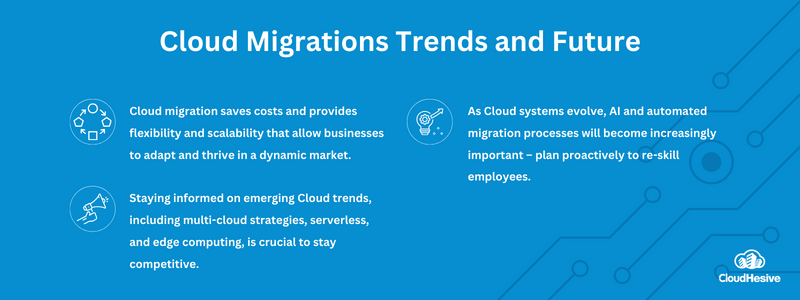
The Cloud offers advanced and efficient security, scalability, and flexibility
All this fuss about Cloud migration. What’s so great about migrating to the Cloud? Isn’t IT the same regardless of the system it’s built on? Cloud migration is widespread because it offers advanced and efficient security, service level scalability, and increased business flexibility.
The flexibility and scalability of your IT infrastructure can make or break a business. Using a Cloud IT infrastructure allows work from anywhere with an internet connection. Not only does it allow businesses to adapt readily and easily to market changes around the globe, but it vastly expands the available labor pool.
This guide describes current Cloud migration trends for reducing costs, increasing scalability, and improving security, along with future Cloud insights.

Introducing Cloud migration
What does Cloud migration mean for a business? Cloud migration is the process of transferring IT management and control from on-premise managed systems to a managed service provider system. A business’s digital assets are transferred from a self-managed network to a provider-managed network.
Digital assets include all business data, including product development, customer information, and financials, to name a few. Basically, during a cloud migration, all the business assets move to the cloud.
Benefits of migrating to the Cloud include:
- On-demand network access from nearly anywhere around the world.
- Advanced security to protect against data loss from cyberattacks.
- Flexible pricing allows businesses to pay for only what they use.
- Greater adaptability to rapidly changing technology.
- Increased flexibility and adaptability provide a competitive edge.
- Cloud IT makes IT easy and employees more productive.
- Powerful analytics tools for data-based decision-making and future insights.
Businesses are already taking good advantage by increasing their use of Cloud services and products by 41.4% annually – 33.4% of companies are finally removing the ball and chain of legacy enterprise software and migrating to the Cloud.
Key drivers for Cloud migration
What makes a business decide to take the leap and migrate to Cloud services? First and foremost, it’s the cost savings. Cloud services can significantly reduce capital expenses related to not only purchasing but also maintaining computer networks, hardware, software, databases, and other devices.
Cloud providers offer a cafeteria-style menu of options where businesses pay for what they need and use, nothing more. Essentially, migrating to the Cloud reduces IT infrastructure waste.
Increased network performance with less downtime also increases employee productivity. When a business migrates to the Cloud, more work gets done at a lower cost. How low? The average savings of using cloud services is 20% annually.
Cloud services also save time. Cloud services reduce system downtime and improve overall performance. Essentially, business networks run faster and more reliably enabling employees to get more work done. Another key driver for Cloud migration is automated business processes.
Cloud services provide embedded tools that can help businesses automate slow, tedious, manual processes. For example, many financial, accounting, and customer service processes can be improved with automation.
Along with process automation, Cloud services also offer the ability to automatically scale systems based on use. For example, systems and workloads that aren’t used overnight can be maintained in a sleep mode and reduce costs. Server performance can be scaled up and down as business demands require. By practicing automatic scaling, businesses save money by only paying for what they use.
Current state and emerging trends in cloud migration
Cloud migration is not new, it’s been around. However, it is constantly expanding across a variety of industries. As early adopters succeed, more businesses follow. The current state of cloud migration is busy. Cloud providers are busy continuously improving and managing security, and are also competitive in providing tools for users to improve and customize systems to meet unique business needs.
Current cloud migration trends also include not only IT infrastructure systems but also specific solutions, applications, and services. Many organizations are adopting variations in cloud offerings by mixing private, public, and hybrid cloud use.
In fact, around 47% of organizations are adopting a cloud-first policy when purchasing and using new applications. Only 27% of companies are still resistant because of a reluctance to hand over security and system control.
With the rise in the adoption of emerging AI and ML technology, many organizations are actively re-skilling employees. Training existing employees to handle the business process impacts of AI and ML is a solid investment in not only the cloud but also one’s existing employee base. After all, the better employees understand cloud services and tools to improve business workflows, products, and processes the better.
Cloud migration’s future
The future of cloud migration is increased automation, greater flexibility for data storage and improved access speeds.
Future trends for cloud migration include:
- AI and ML automation.
- Serverless processing.
- Edge computing for faster data performance.
- Rise of industry-specific Cloud systems.
- Increased data storage and transfer capabilities.
- Cloud migration deployment improvements through automated processing.
Industry-specific Cloud systems will improve adaptability and the flow of highly innovative products to market. They can also improve solutions to be designed for specific industry needs. No more having to completely customize Cloud services. Businesses can start with an industry Cloud and build from a more focused base.
Future insights for Cloud computing also include continuous improvements in building advanced security that’s easy to configure yet effective in preventing security issues. Add to that more stringent and consistent monitoring methods that can more easily detect, track, and stop attacks before they get started. Cloud computing will continue to improve its offerings for preventing downtime or business interruptions during critical weather events or natural disasters.
The future of Cloud migration means the price goes down. As Cloud migrations become more routine and more secure, the cost will continue to go down. With lower access costs, more businesses will migrate to Cloud services. A strong Cloud provider market means intense competition to provide customers with the best service and price.
Are you ready for Cloud migration?
Time to consider cloud migration?
Ask yourself – is your startup business intended to function in the future? Do you want to function, grow, or both? Now’s the perfect time to migrate and leverage the benefits of the cloud.
Want even more advantages from the cloud? Consider building a business partnership with a quality MSP.
If you’ve not got the time to take your eyes off other aspects of your business, work with an MSP like CloudHesive. CloudHesive helps you create a winning cloud migration strategy and manages every step of the process using a three-phase method. Each phase is completed and tested, ending with a successful migration.
CloudHesive specialists represent a global team with 24/7 support and continuous security monitoring. With CloudHesive you get secure, compliant, risk-averse cloud migration, and the best AWS tools available.
As an Amazon Managed Services partner and Amazon Premier Partner, CloudHesive helps any organization experience the benefits and power of the AWS cloud system.



